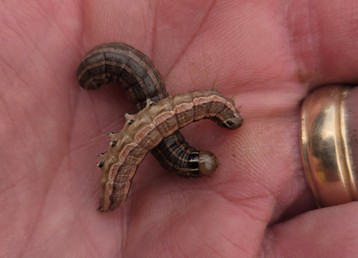Bronze Cutworm

Bronze cutworms have been found in Butler County. These cutworms are typically a problem in turf but can also impact other species. Cutworms overwinter as eggs, larvae, or pupae, depending on the species, and damage to turf will typically occur in May. Larvae feed on the leaves and crown at night and may cut off plants near the soil line. Look for cut-off seedlings and dig around the base of the plant to expose the caterpillars. During the day, they hide in holes, under debris, or under thatch near the soil's surface, on the leaves and crown at night.
An infestation in turf can be detected by applying irritants such as dish detergent. Add one-quarter cup of dry or one ounce of liquid detergent to one gallon of water in a sprinkling can and apply the solution to one square yard of turfgrass where an infestation is suspected. The caterpillars will surface within 10 minutes of soaking and can be found by separating the blades of grass. Turf should be treated if five or more cutworms are found per square yard. If the cutworms are in the garden, there are preventative measures you can use. To prevent damage from surface cutworms, wrap seedlings and transplants with cardboard collars to protect them from cutworm damage. A simple collar can be made from a paper cup with the bottom removed. Push the cup into the soil to hold it in place. Cardboard tubes from paper towels or toilet tissue can be cut to size for collars. Standard treatment options include products with the active ingredients of Bt, Spinosad, permethrin, carbaryl, or bifenthrin.

Have questions? Contact our office where our Horticulture Extension Agent will assist you with questions.
Phone: (316) 321-9660
Email: callae@ksu.edu